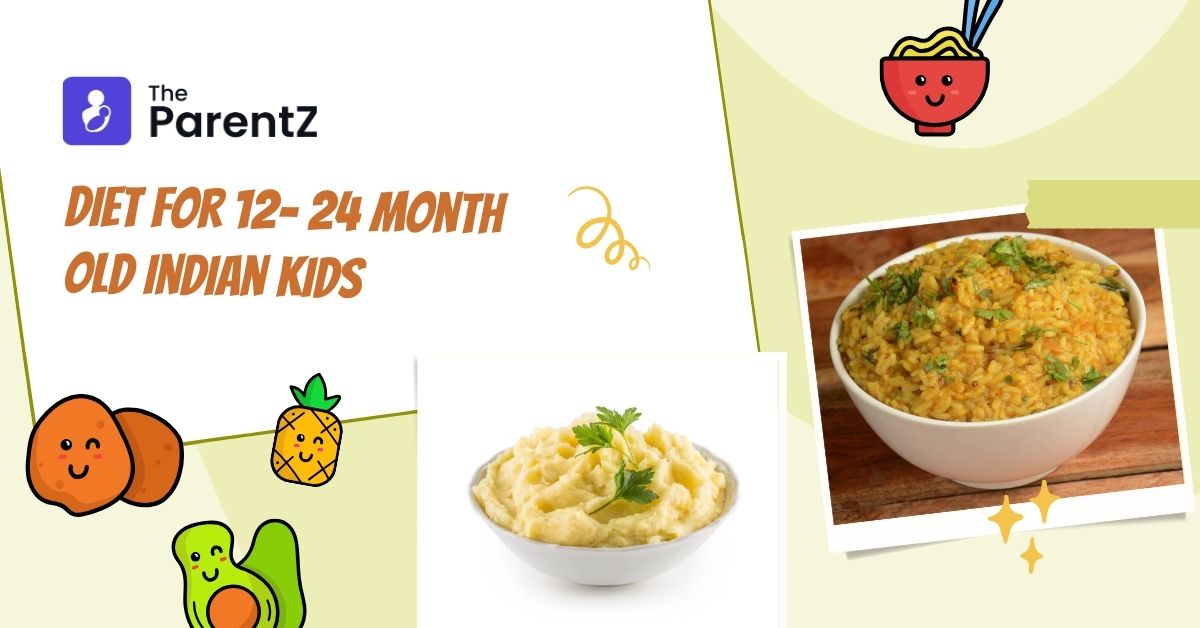Happy 1st birthday to you child and Happy 1st year of Parenthood! What a rollercoaster journey it has been, isn’t it?
With all the inevitable changes and milestones, one thing remains constant: your concern for your baby’s proper growth in today’s article we will discuss the way forward.
Adequate nutrition during the first two years is crucial for a child’s growth and development. For Indian children aged 12-24 months, following WHO guidelines can help ensure they receive a balanced diet that meets their nutritional needs.
This article provides detailed dietary advice and a comprehensive Indian diet plan for toddlers in this age group.
WHO Guidelines Overview
The World Health Organization (WHO) emphasizes the importance of complementary feeding alongside continued breastfeeding up to 2 years of age or beyond. Key points include:
- Breastfeeding: Continue breastfeeding on demand. Breast milk remains a vital source of nutrients.
- Meal Frequency: 3-4 meals daily, with 1-2 additional snacks as required.
- Nutrient-rich foods: Include a variety of foods to cover all nutrient needs, focusing on energy, protein, and micronutrients.
- Texture and Consistency: Gradually increase food texture from mashed and lumpy to family foods by 12 months.
- Iron and Vitamin A: Ensure sufficient iron and vitamin A intake through diverse food sources.
- Hygiene: Maintain high food and personal hygiene standards to prevent infections.
Comprehensive Indian Diet Plan
Daily Nutrient Requirements
- Energy: Approximately 1,000-1,200 kcal/day.
- Protein: About 13 grams/day.
- Iron: 7 mg/day.
- Calcium: 500 mg/day.
- Vitamin A: 400 µg/day.
- Fats: 30-40% of total energy intake.
Sample Meal Plan
The following plan includes a variety of Indian foods to meet the nutritional requirements:
Early Morning (6:00-7:00 AM)
- Breastfeeding or Whole Milk (150-200 ml): Provides essential fats and calcium.
Breakfast (8:00-9:00 AM)
- Ragi Porridge: 2 tbsp ragi flour (finger millet) cooked in water/milk, sweetened with jaggery.
- Benefits: Rich in calcium and iron.
Mid-Morning Snack (10:30-11:00 AM)
- Seasonal Fruit Chunks: Mango, papaya, apple, or pear
- Benefits: Vitamins, especially vitamin C and fibre.
Lunch (12:30-1:00 PM)
- Vegetable Khichdi: 2 tbsp rice, 1 tbsp moong dal, mixed vegetables (carrot, beans, peas) cooked together, and a pinch of turmeric and cumin.
- Benefits: Balanced meal with carbohydrates, protein, and vitamins
- Curd: (2-3 tbsp)
- Benefits: Probiotics and calcium.
Afternoon Snack (3:00-4:00 PM)
- Whole Wheat Biscuits or Homemade Laddu: Made with whole wheat flour, jaggery, and ghee.
- Benefits: Energy and iron.
Evening (5:30-6:00 PM)
- Mashed Sweet Potato or Boiled Potato
- Benefits: Complex carbohydrates and vitamins.
Dinner (7:30-8:00 PM)
- Chapati with Dal and Vegetables: 1 small chapati, mashed dal (lentils), and finely chopped, lightly cooked vegetables.
- Benefits: Fiber, protein, and essential nutrients.
Bedtime (9:00-9:30 PM)
- Breastfeeding or Whole Milk (100-150 ml): Provides satiety and nutrients.
Nutritional Tips and Recipes
1. Ragi Porridge Recipe
- Ingredients: 2 tbsp ragi flour, 1 cup water/milk, 1 tsp jaggery.
- Method: Mix ragi flour with water/milk to avoid lumps. Cook on low heat until thick. Add jaggery and mix well.
2. Vegetable Khichdi Recipe
- Ingredients: 2 tbsp rice, 1 tbsp moong dal, 1/4 cup mixed vegetables, pinch of turmeric, cumin seeds.
- Method: Wash rice and dal. In a pressure cooker, add rice, dal, vegetables, spices, and 1 cup water. Cook for 3-4 whistles until soft.
3. Mashed Sweet Potato Recipe
- Ingredients: 1 small sweet potato.
- Method: Boil sweet potato until soft. Peel and mash with a fork. Optionally, add a pinch of salt or butter.
Additional Tips
- Variety and Balance: Ensure meals include a mix of cereals, pulses, fruits, and vegetables.
- Hydration: Offer water regularly. Avoid sugary drinks and limit fruit juices.
- Healthy Snacks: Include nutrient-dense snacks like fruits, nuts (powdered for safety), and whole grains.
- Avoid Processed Foods: Limit foods high in sugar, salt, and unhealthy fats.
- Cultural Preferences: Adapt recipes to include regional ingredients while maintaining nutritional balance.
Conclusion
Feeding children aged 12-24 months requires careful attention to their nutritional needs to support their rapid growth and development. Following WHO guidelines and incorporating a diverse range of Indian foods can help ensure that toddlers receive a balanced diet. By offering a variety of healthy, home-cooked meals and maintaining good hygiene practices, parents can lay the foundation for their children’s long-term health and well-being.









Be the first one to comment on this story.